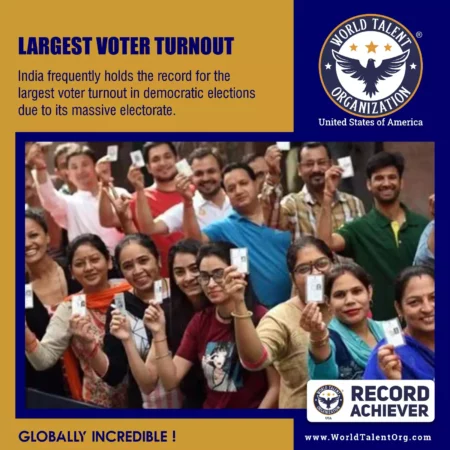
In the realm of democratic elections, India stands as a shining example of unprecedented voter turnout, consistently clinching the record for the largest participation in the electoral process. This phenomenon can be attributed to a multitude of factors that converge to create a vibrant tapestry of democratic engagement.India, a country renowned for its diverse culture and immense population, boasts an extraordinary feat – the highest voter turnout in democratic elections globally. This remarkable participation is not a coincidence but a product of numerous intertwined factors that motivate and engage citizens to exercise their democratic rights.
Factors Influencing Voter Turnout
Social Awareness and Mobilization
In a nation as vast and varied as India, social awareness plays a pivotal role in driving voter turnout. Grassroots initiatives, community-led campaigns, and the tireless efforts of non-governmental organizations collectively foster a culture where citizens understand the significance of their vote.
Election Policies and Accessibility
India’s commitment to inclusive elections has facilitated an environment conducive to high participation. The Election Commission’s policies, such as establishing polling booths in remote areas and providing special accommodations for the elderly and differently-abled, ensure that every eligible citizen can cast their vote.
Civic Duty and Nationalism
The strong sense of civic duty and nationalism prevalent in India further bolsters voter turnout. Citizens perceive voting not only as a right but also as a responsibility towards shaping the nation’s future. This sentiment binds the diverse population in a common democratic endeavor.
Technology’s Role in Facilitating Participation
Online Voter Registration
In recent years, technology has revolutionized the voter registration process. Online platforms have made registering to vote seamless and efficient, reducing bureaucratic hurdles and expanding the voter base.
Real-time Information Dissemination
Technology’s influence extends beyond registration. Real-time dissemination of information, from candidate profiles to polling booth locations, empowers voters with the knowledge they need to make informed decisions, enhancing the overall voting experience.
Challenges in Sustaining High Voter Turnout
Addressing Voter Apathy
While India boasts impressive numbers, combating voter apathy remains an ongoing challenge. Initiatives focusing on civic education and the impact of individual votes can contribute to sustaining the enthusiasm seen in high-turnout elections.
Overcoming Infrastructural Barriers
India’s diverse geography presents infrastructural challenges. Remote areas with limited connectivity often struggle to match the participation rates of urban counterparts. Bridging this gap requires innovative solutions, such as mobile polling stations.
Comparative Analysis of Global Voter Turnout
India’s Lead in Numbers
India’s massive voter turnout sets it apart from other nations. While percentages vary, the sheer volume of voters who exercise their rights demonstrates the nation’s commitment to democratic values.
Cultural and Structural Variances
Comparing voter turnout across nations demands a nuanced approach. Cultural attitudes, historical contexts, and structural differences contribute to the variations observed, making each country’s democratic landscape unique.
Youth Engagement and Future Trends
Youth as Catalysts for Change
Engaging the youth is critical for the sustained success of high voter turnout. They bring fresh perspectives, enthusiasm, and the potential to drive transformative change through the democratic process.
Incorporating Modern Tools for Engagement
Recognizing the tech-savvy nature of today’s youth, leveraging social media, interactive apps, and gamified learning experiences can amplify youth engagement, transforming them from passive observers to active participants.
Evolving Notions of Democracy and Participation
Inclusivity and Diversity
Modern democracy extends beyond voting; it encompasses active participation in shaping policies. Inclusivity and diverse representation empower marginalized voices, enriching the democratic discourse.
From Voting to Civic Engagement
The evolution of democracy involves a shift from isolated voting events to continuous civic engagement. Citizens’ involvement in governance processes ensures accountability and transparency.
Government Initiatives and Grassroots Movements
Schemes Promoting Voter Awareness
Government initiatives, like National Voters’ Day, celebrate the importance of voting and educate citizens about their role in the democratic process. These efforts instill a sense of pride in civic participation.
Collaborative Efforts for Mobilization
Grassroots movements, supported by civil society organizations and political parties, contribute significantly to voter mobilization. These collective endeavors amplify the reach and impact of voter awareness campaigns.
Conclusion
India’s consistent top-ranking voter turnout exemplifies the nation’s unwavering commitment to democracy. The amalgamation of social awareness, technological advancements, and a deeply ingrained sense of civic duty has propelled India to the forefront of global democratic engagement. As the nation continues to evolve, embracing the potential of youth and technology, its legacy as a democratic trailblazer seems destined to endure.
Why does India consistently lead in voter turnout?
India’s high voter turnout can be attributed to factors such as social awareness, inclusive policies, and a strong sense of civic responsibility.
How can technology bridge the gap in voter accessibility?
Technology facilitates online voter registration, provides real-time information, and brings polling booths closer to remote areas, ensuring broader voter accessibility.
What are the implications of high voter turnout on governance?
High voter turnout enhances the legitimacy of elected representatives, promotes policies aligned with public interests, and strengthens the overall democratic framework.
What measures are employed to enhance youth participation?
Initiatives involving technology, social media, and educational campaigns are utilized to engage and motivate the youth to participate actively in the democratic process.
What role do local communities play in encouraging voter turnout?
Local communities often spearhead awareness campaigns, fostering a culture of participation and emphasizing the impact of individual votes on community welfare.

